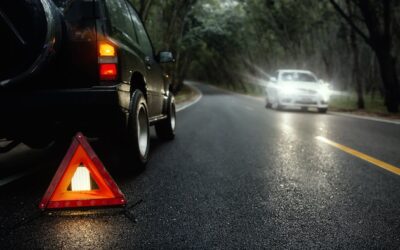Everyone knows one thing about stopping distances: It takes longer for your car to stop on wet surfaces than it does on dry surfaces. But what does the Highway Code have to say about this issue?

If you’re learning to drive and preparing for your theory test, it’s worth familiarising yourself with the Highway Code’s position on stopping distances.
Stopping Distances and Weather: Dry, Rain and Snow
Different weather conditions can affect how you drive, including stopping distances.
Here we’ll look at how dry weather, rain, snow and ice can affect your stopping distances.
Stopping Distances in Dry Conditions
The Highway Code’s site includes this handy graphic to illustrate how speed affects your thinking distance and braking distance:

Some have pointed out that this information may be outdated, as it doesn’t take into consideration advances in braking and tyre technology.
However, even if this information is a little dated, we still feel this is a handy guide. It effectively illustrates that the faster you’re travelling, the less time you’ll have to think, and the longer it will take you to brake.
So think of these figures as “worst case scenario” figures. It might not take you precisely 55m to come to a complete stop at 60mph, but it’s still going to take you longer than it would at 50mph. With this in mind, commit to becoming as safe a driver as you can. Leave as much space as you can between your car and the car in front, and always give the road your complete and undivided attention.
Stopping Distances in Rain
Wet surfaces can almost double your stopping distances. If the road is wet, make sure you slow down to give you more space to stop.
When the road is wet, there’s even more to think about like the conditions inside the car, maintaining visibility as well as the possibility of aquaplaning. Read our guide to stopping distances in the rain.
Stopping Distances in Snow and Ice
Driving in snow or on ice can make your stopping distances 10 times longer.
Driving in higher gears and more smoothly are just some of the extra considerations you need when driving in snow and ice. Find out more about driving in snow and ice with our guide to driving in the snow and our guide on how to tell if you’re driving on ice and what to do.
Stopping Distances and The Highway Code
Your stopping distance will depend on five factors:
- Your attention
- Your speed
- The road surface
- The weather
- Your vehicle
Your Attention – If you’re tired or distracted, you’ll be slower to react to events on the road ahead of you. You’ll hit the brakes a little later than you would have done if you were giving the road your complete attention. This is why it’s important to think of the two second rule when it comes to stopping distances. Read more about the two second rule here.
Your Speed – The faster you’re travelling, the longer it will take for your car to come to a complete stop. This isn’t just because it will take a while for your car to brake. It’s also because, at high speeds, you’ll travel further before you realise that you need to brake – even if your reaction is instantaneous. This is called the “thinking distance”, and you can learn more about it on our blog about the dangers of tailgating.
The Road Surface – Not all road surfaces are equal. Some are gravelly, some are greasy, and after periods of rain and snow, road surfaces can be wet, icy, and slippery. All of these things will increase your stopping distance. The problem is that it can be hard to tell just what type of road surface you’re travelling on. This is particularly true when it comes to ice, which isn’t always visible to the naked eye. Read our guide to what to do if you find you’re driving on ice here.
The Weather – Rain, snow, sleet and other weather conditions can increase your stopping distance through affecting your attention and through making the road surface slippery. Read our guide to stopping distances in the rain here, and our guide to driving in the snow here.
Your Vehicle – The age and condition of your vehicle can affect your stopping distances. Modern cars can be fitted with advanced braking systems, while older cars can have worn or outdated brakes and tyres. Read our guide to how the condition of your tyres in particular can affect your stopping distances here.
And get yourself covered with comprehensive car insurance, so that everything will be taken care of should you ever get involved in an incident.



